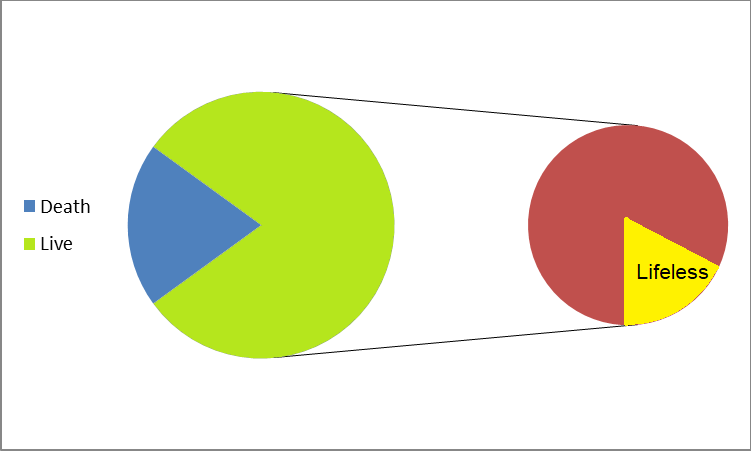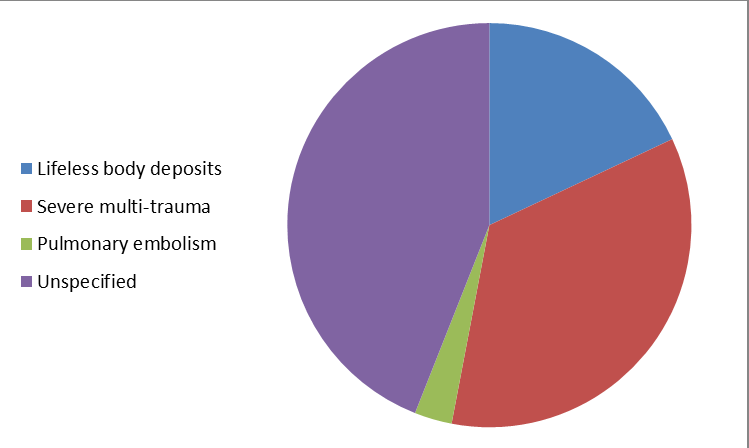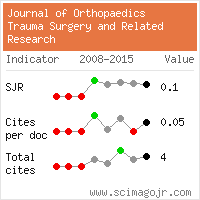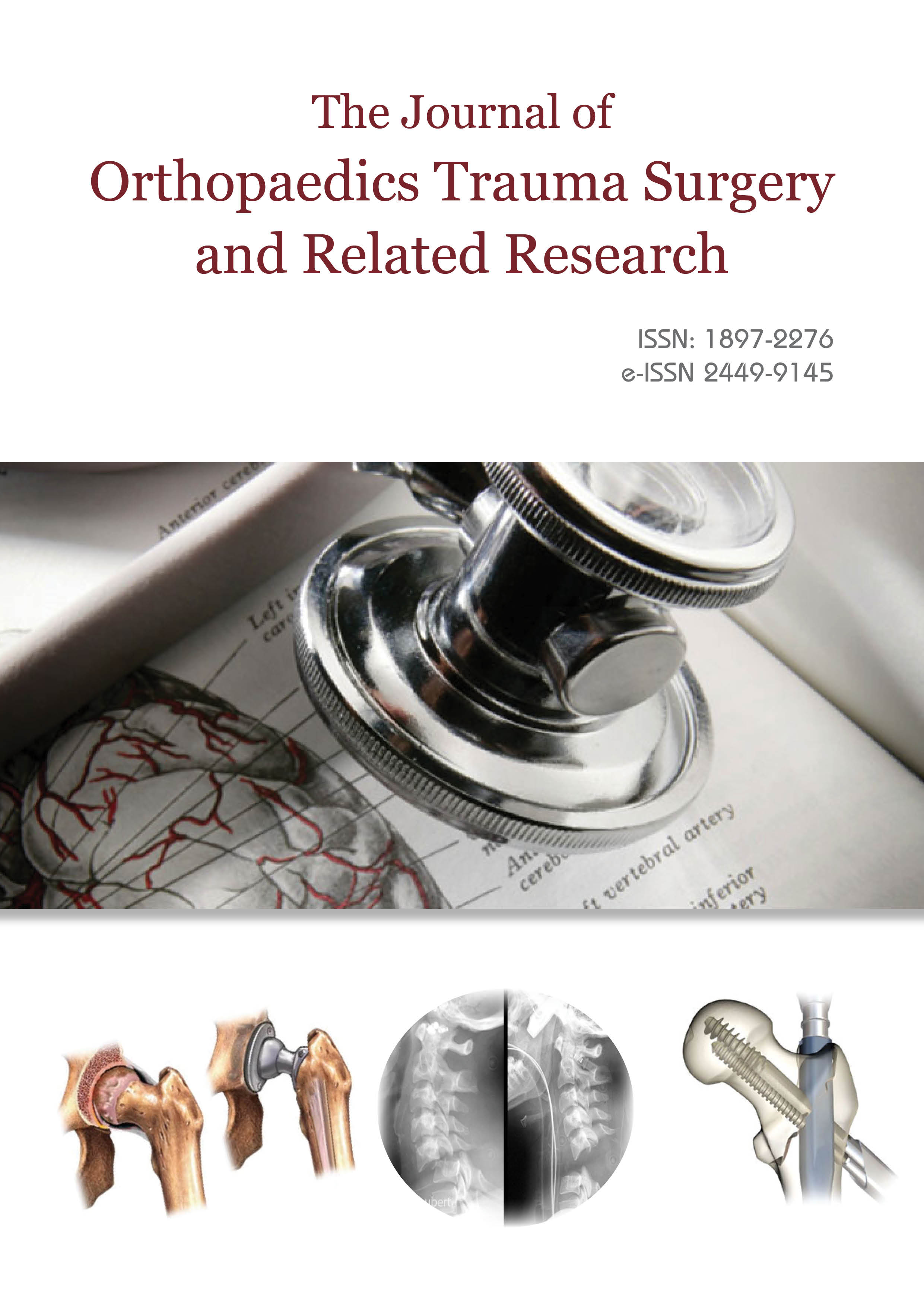Crude death rate and complication in Iraqi patients with pelvic bones fractures
2 Al-Fayhaa Teaching Hospital, Basrah Health Directorate, Ministry of Health, Basrah, Iraq
3 Al-Zubair general hospital, Basrah Health directorate, Ministry of Health, Basrah, Iraq
Received: 10-Jun-2025, Manuscript No. jotsrr-25-166596 ; Editor assigned: 13-Jun-2025, Pre QC No. jotsrr-25-166596 (PQ); Reviewed: 27-Jun-2025 QC No. jotsrr-25-166596 ; Revised: 11-Aug-2025, Manuscript No. jotsrr-25-166596 (R); Published: 18-Aug-2025
This open-access article is distributed under the terms of the Creative Commons Attribution Non-Commercial License (CC BY-NC) (http://creativecommons.org/licenses/by-nc/4.0/), which permits reuse, distribution and reproduction of the article, provided that the original work is properly cited and the reuse is restricted to noncommercial purposes. For commercial reuse, contact reprints@pulsus.com
Abstract
Background: Pelvic fractures are relatively frequent injuries that can range in severity from minor, isolated bone fragments to complex disruptions of the pelvic ring. The aim of this work was to study the prognosis of pelvic fractures in the orthopedic department. Methods: We conducted a retrospective, descriptive, monocentric study over a period of five years. The study included a total of 194 cases: 150 hospitalized patients diagnosed with pelvic fractures and 44 deceased individuals with pelvic fractures identified upon admission to the mortuary. The study population was predominantly male (n=105), with females accounting for 45 cases. The mean age was 40.22 years, indicating a higher incidence among young adults. Radiological assessment of the fractures was performed using Tile’s classification system, with type A fractures being the most frequently observed. The prognosis of pelvic fractures was evaluated based on mortality rates, the occurrence of complications, and the presence of long-term sequel. Results: Mortality was observed in 20% of the cases (n=30), with lifeless body deposits being the most frequent cause, accounting for 18%. Among patients who arrived at the facility alive, the highest mortality rate occurred within the first 24 hours (12%), after which the death rat gradually decreased over time. Autopsies were conducted in all fatal cases, revealing that 35% of deaths were due to severe multi-trauma, while 3% resulted from pulmonary embolism. In cases involving severe trauma that led to death, cranial injuries accounted for 11%, thoracic contusions for 16%, abdominal contusions for 7%, pelvic vascular injuries for 13%, and lower limb fractures for another 13%. Complications were primarily vascular injuries (13%), followed by urinary system injuries (8%). Open wounds were present in 5% of patients. Vascular complications were most common in type C injuries (8%), with a statistically significant link between lesion type and vascular issues (p=0.002). All urinary complications (8%) were associated with injuries to the anterior arch. Specifically, isolated anterior arch injuries caused 4% of urethral ruptures and 2% of bladder ruptures. Conclusion: The prognosis of pelvic fractures in our setting is marked by a high early mortality rate. This elevated mortality is primarily attributable to immediate life-threatening complications and associated injuries that result in multi-trauma.
Keywords
Pelvis trauma; Ring fracture; Urinary Incontinence; Multi-trauma
Introduction
Pelvic fractures are relatively frequent injuries that can range in severity from minor, isolated bone fragments to complex disruptions of the pelvic ring. The clinical implications vary accordingly: While minor fractures may heal with conservative treatment, major pelvic ring disruptions often require urgent surgical intervention and carry a high risk of morbidity and mortality [1,2].
Road Traffic Accidents (RTAs) are the leading cause of these injuries, frequently resulting from high-energy trauma. Such forces can compromise the structural integrity of the pelvis, often in conjunction with other life-threatening injuries, which complicates both diagnosis and management. Despite advances in trauma care, the mortality rate for severe pelvic fractures remains significant, particularly in hemodynamically unstable patients [3,4].
The prognosis of pelvic fractures can be critical from the outset due to the high incidence of hemorrhagic shock. This is often the result of vascular injury or significant bleeding from fractured bony surfaces. The risk of infection is also considerable, particularly in open fractures or when there is involvement of intra-pelvic visceral organs such as the rectum, bladder, or urethra. From a functional standpoint, the prognosis remains guarded. This is primarily due to the frequent occurrence of long-term sequel, including neurological deficits, genitourinary complications, and, most notably, osteo-articular dysfunction. These outcomes are often the result of fractures that are inadequately reduced or stabilized, underscoring the importance of prompt and precise management [5,6].
Methods
We conducted a retrospective, descriptive, monocentric study over a period of five years. The study included a total of 194 cases: 150 hospitalized patients diagnosed with pelvic fractures and 44 deceased individuals with pelvic fractures identified upon admission to the mortuary.
The study population was predominantly male (n=105), with females accounting for 45 cases. The mean age was 40.22 years, indicating a higher incidence among young adults.
Radiological assessment of the fractures was performed using Tile’s classification system, with type A fractures being the most frequently observed.
The prognosis of pelvic fractures was evaluated based on mortality rates, the occurrence of complications, and the presence of long-term sequel.
Tile classification of pelvic fractures [7,8]:
Type A: Stable fractures
Type B: Rotationally unstable, vertically stable
Subtypes:
•B1: External rotation (open-book injury).
•B2: Internal rotation (lateral compression).
•B3: Bilateral compression or combined injuries.
Type C: Rotationally and vertically unstable
Subtypes:
•C1: Unilateral posterior injury.
•C2: Bilateral, with one side rotationally andvertically unstable.
•C3: Bilateral, both sides vertically unstable.
CLINICAL RELEVANCE
•Type A fractures generally have a goodprognosis with conservative management.
•Type B injuries often need external or internalfixation, depending on displacement.
•Type C fractures carry a high risk of Crude death rate and complication in Iraqi patients with pelvic bones fractures 3
20 (1) 2025
hemorrhage, visceral injury, and mortality, requiring urgent and complex surgical management.
STATISTIC
All statistical analyses were performed using (SPSS, 24 version), with a significance set at p<0.05. Descriptive statistics were expressed as mean ± SD and median, while categorical variables were summarized as frequencies and percentages. Chi-square (χ²) tests were used for categorical variables.
Results
Mortality was observed in 20% of the cases (n=30), with lifeless body deposits being the most frequent cause, accounting for 18%. Among patients who arrived at the facility alive, the highest mortality rate occurred within the first 24 hours (12%), after which the death rate gradually decreased over time (Figure 1).
Autopsies were conducted in all fatal cases, revealing that 35% of deaths were due to severe multi-trauma, while 3% resulted from pulmonary embolism (Figure 2). In cases involving severe trauma that led to death, cranial injuries accounted for 11%, thoracic contusions for 16%, abdominal contusions for 7%, pelvic vascular injuries for 13%, and lower limb fractures for another 13% (Figure 3).
Complications were primarily vascular injuries (13%), followed by urinary system injuries (8%). Open wounds were present in 5% of patients. Vascular complications were most common in type C injuries (8%), with a statistically significant link between lesion type and vascular issues (p=0.002). All urinary complications (8%) were associated with injuries to the anterior arch. Specifically, isolated anterior arch injuries caused 4% of urethral ruptures and 2% of bladder ruptures. When both anterior and posterior arches were involved, 2% of cases resulted in urethral rupture and another 2% in bladder rupture. However, there was no significant statistical relationship between the injury site and urinary complications (p=0.9). Pulmonary embolism was noted in 2% of all cases (Table 1).
| Complication type | % | Details | P value |
|---|---|---|---|
| Vascular injuries | 13 | Most common in type C injuries (8%) | 0.002 |
| Urinary system injuries | 8 | All associated with anterior arch injuries | 0.9 |
| • Urethral rupture | 6 | 4% from isolated anterior arch; 2% from combined anterior/posterior arch | |
| • Bladder rupture | 4 | 2% from isolated anterior arch; 2% from combined anterior/posterior arch | |
| Open wounds | 5% | — | — |
| Pulmonary embolism | 2% | — | — |
Table 1. Complications in patients with pelvic injuries.
Discussion
One-fifth of our patients died (20%), a figure that lies above the commonly reported mortality rate for pelvic trauma, which typically ranges between 5% and 15%, but can reach up to 50% in extreme cases [5-8]. Khaled et al. [9]reported a mortality rate of 19% among multi-traumapatients with pelvic fractures, which aligns closely withour findings. The high mortality observed in our studycan be partially attributed to our inclusion of pre-hospitalfatalities-patients who died before reaching theemergency department. It is likely that among thesedeceased multi-trauma cases, some had undiagnosedpelvic fractures. Lifeless body deposits accounted for themajority (18%), likely reflecting the severity of trafficaccidents common in urban settings and the inadequatepre-hospital care systems [10].
Among patients who arrived at the hospital alive, the highest mortality occurred within the first 24 hours (12%), followed by a gradual decline in deaths over subsequent days. This early mortality rate is notably higher than that reported by Caitlin et al. [11], who found a 2% mortality rate in a similar cohort. The disparity may be explained by the limited availability of specialized trauma equipment and trained personnel in our emergency departments. Furthermore, the absence of an integrated, multidisciplinary approach to managing pelvic trauma contributes significantly to the high early mortality rate.
Hemorrhagic shock was observed in 25.68% of patients in our study. This finding is consistent with those reported by [2] and [1], who found rates of 20% and 28%, respectively, among patients presenting in a state of shock. The high frequency of hemodynamic instability in our cohort is likely attributable to vascular injuries associated with pelvic fractures particularly in cases of unstable fractures and the frequent presence of additional extra-pelvic injuries. In the study by Khaled et al. [9], a higher rate of hemorrhagic shock (48%) was reported, which may be explained by the predominance of type C pelvic fractures (58%) in their patient population. These lesions are more likely to cause severe bleeding due to their unstable nature and extensive vascular involvement.
In our series, vascular complications were the most frequently observed associated pelvic injuries, accounting for 15% of cases. This finding is in line with the results of [1]and [4], who reported vascular lesion rates of 21% and10%, respectively. The high frequency of vascularinjuries can be attributed to the rich vascularization of thepelvic region. Additionally, pelvic vessels lie in close proximity to the bony structures and are highly susceptible to damage during high-impact trauma that results in pelvic fractures.
Urinary complications were observed in 7.65% of our patients, with urethral rupture being the most common (4.91%). All cases involved the membranous portion of the urethra. This pattern is consistent with the findings of [3]and [2], where urinary tract injuries were reported asthe most common immediate complications, occurring in34% and 17.15% of cases, respectively predominantlyinvolving urethral ruptures. Across multiple studies, thefrequency of urinary complications ranges up to 12%,with a clear predominance of membranous urethralinvolvement.
According to Dobrowolski et al. [12], membranous urethral rupture is the most frequent urinary tract injury in the context of pelvic trauma, accounting for up to 90% of cases. This is often associated with fractures of the anterior pelvic arch. The anatomical vulnerability of the membranous urethra is due to its course through the urogenital diaphragm, which has been described as being as sharp as a “razor blade,” making it particularly susceptible to laceration during traumatic events [13].
Given the high early mortality associated with pelvic fractures in our context, several strategic improvements are necessary to enhance patient outcomes: Strengthen pre-hospital care (Trauma victims should be managed at the scene by trained medical personnel using appropriately equipped ambulances and the implementation of organized Emergency Medical Services (EMS) capable of rapid response and early stabilization is critical); Promote multidisciplinary hospital management: (The management of severe pelvic fractures should involve a coordinated, multidisciplinary team including trauma surgeons, orthopedic surgeons, urologists, anesthesiologists, and critical care specialists and hospitals should establish dedicated trauma protocols and improve access to specialized trauma units); Invest in infrastructure and training: (Upgrade trauma centers with appropriate imaging, surgical tools, and resuscitation equipment tailored to manage complex pelvic injuries and regular training and simulation programs should be conducted for emergency and surgical teams to maintain high readiness levels); Establish pelvic trauma registries and surveillance systems: (Creating a local or national registry for pelvic trauma would allow for better tracking of incidence, outcomes, and care quality, facilitating evidence-based improvements and; Public awareness and prevention: Campaigns aimed at reducing road traffic accidents the leading cause of pelvic fractures should be reinforced through public education, better traffic enforcement, and urban planning.
Conclusion
The prognosis of pelvic fractures in our setting is marked by a high early mortality rate. This elevated mortality is primarily attributable to immediate life-threatening complications and associated injuries that result in multi-
trauma. To improve outcomes for these patients, two key measures are essential: First, the pre-hospital care system must be strengthened, with trauma victims being attended to and transported by medically equipped ambulances; second, the in-hospital management of severe pelvic fractures should adopt a multidisciplinary approach, involving coordinated efforts from trauma surgeons, orthopedic specialists, urologists, and critical care teams. These steps are crucial for reducing early mortality and enhancing the overall prognosis of pelvic trauma patients.
Authors Contributions
1. Conceptualization; data curation; investigation; methodology; project administration; resources; software; writing-original draft and writing review and editing.
2. Conceptualization; data curation; investigation; methodology; project administration; writing original draft and writing review and editing.
3. Conceptualization; data curation; investigation; methodology; project administration; resources; writing original draft and writing review and editing.
Conflicts of Interest
The authors declare no conflict of interest regarding this article.
References
- Tullington JE, Blecker N. Pelvic Trauma. StatPearls. 2025.
- Halvorson JJ, Lamothe J, Martin CR, et al. Combined acetabulum and pelvic ring injuries. J Am Acad Orthop Surg. 2014;22(5):304-4.
- Yu YH, Liu CH, Hsu YH, et al. Matta's criteria may be useful for evaluating and predicting the reduction quality of simultaneous acetabular and ipsilateral pelvic ring fractures. BMC Musculoskelet Disord. 2021;22(1):544.
[Crossref] [Google Scholar] [PubMed]
- Puchwein P, Sandersjöö G, Lindahl J, et al. Combined pelvic ring and acetabular fractures-strategies and sequence of surgery. Arch Orthop Trauma Surg. 2024;144(10):4577-86.
[Crossref] [Google Scholar] [PubMed]
- Wong MYZ, Ghobrial M, Han WM, et al. The floating hip injury: A descriptive study and case-control analysis. Hip Int. 2024;34(1):122-33.
[Crossref] [Google Scholar] [PubMed]
- Bhattachan S. Open pelvic fracture with rectal laceration: A case report. JNMA J Nepal Med Assoc. 2021;59(240):802-4.
[Crossref] [Google Scholar] [PubMed]
- Tienpratarn W, Nakpipat N, Yuksen C, et al. Clinical associated factors of Tile B/C type of pelvic ring fractures: a retrospective cross-sectional study. Arch Acad Emerg Med. 2024;12(1):e49.
[Crossref] [Google Scholar] [PubMed]
- Vichiensanth P, Leepayakhun K, Yuksen C, et al. Predicting the need for tertiary trauma care using a multivariable model: A 4-year retrospective cohort study. Arch Acad Emerg Med. 2025;13(1):e37.
[Crossref] [Google Scholar] [PubMed]
- Khaled SA, Soliman O, Wahed MA. Functional outcome of unstable pelvic ring injuries after iliosacral screw fixation: Single versus two screw fixation. Eur J Trauma Emerg Surg. 2015;41(4):387-92.
[Crossref] [Google Scholar] [PubMed]
- Caillot M, Hammad E, Le Baron M, et al. Pelvic fracture in multiple trauma: a 67-case series. Orthop Traumatol Surg Res. 2016;102(8):1013-6.
[Crossref] [Google Scholar] [PubMed]
- Fitzgerald CA, Morse BC, Dente CJ. Pelvic ring fractures: Has mortality improved following the implementation of damage control resuscitation? Am J Surg. 2014;208(6):1083-90.
[Crossref] [Google Scholar] [PubMed]
- Dobrowolski ZF, Weglarz W, Jakubik P, et al. Treatment of posterior and anterior urethral trauma. BJU Int. 2002;89(7):752-4.
[Crossref] [Google Scholar] [PubMed]
- Odzébé AW, Bouya PA, Otiobanda GF, et al. Les complications urologiques des fractures de la ceinture pelvienne: à propos de 22 cas au CHU de Brazzaville. Prog Urol. 2013;23(7):474-9.






 Journal of Orthopaedics Trauma Surgery and Related Research a publication of Polish Society, is a peer-reviewed online journal with quaterly print on demand compilation of issues published.
Journal of Orthopaedics Trauma Surgery and Related Research a publication of Polish Society, is a peer-reviewed online journal with quaterly print on demand compilation of issues published.